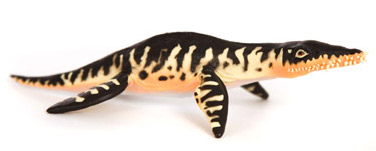New Liopleurodon Model Available
Ever since Liopleurodon was featured in episode three of the BBC TV series Walking with Dinosaurs (episode called “The Cruel Sea”), this large, marine reptile has been a firm favourite with young dinosaur fans.
Liopleurodon
Such is the power of television programmes such as these and the subsequent video and DVD sales, what was presented in a factual documentary format is now accepted as scientific truth by many viewers. This BBC series has received criticism in the past over its dramatisation of events that may or may not have occurred, for example at the time of its first broadcast there were a number of doubts expressed over the programme’s authenticity. An article published in a leading UK broadsheet newspaper “Who put the “P” in Postosuchus”, summed up some of the concerns from the scientific community nicely. In order to tell a story, the writers and producers of the series had created certain scenarios that, although based on some fossil evidence could not be substantiated. For instance, the large carnivorous Postosuchus marking its territory with urine (the reason for the headline in the newspaper). Scientists have speculated that this large predator probably hunted alone and required a large territory to sustain it. Perhaps they would have developed an aggressive display towards others which may have involved urinating to mark their presence in an area.
Walking with Monsters
In the DVD of Walking with Monsters, one of the special features deals with how the writers and researchers tackled some of these issues. It is all a matter of how the evidence is interpreted and how much licence the writers have to use their imaginations to create probable plots and scenarios.
However, with Liopleurodon the fossil evidence was somewhat more stretched and the claims made for the size of these pliosaurs were (based on the evidence to date), exaggerated.
An earlier blog article touched upon this issue: How big was Liopleurodon?
So popular is Liopleurodon that this particular article was placed at number 3 in our top ten list of the most read articles in our annual review of our web log.
To view the top five, including the Liopleurodon article: The most popular web log articles of 2007 (part 2 – the top five).
Liopleurodon is still regarded by many as being the top predator of the Mesozoic, comparisons are made with Tyrannosaurus rex and other dinosaurs and Liopleurodon is compared very favourably. We found an example of this when reviewing the Walking with Dinosaurs 2001 annual. An article in this book covered “Dinowars”, an imagined contest between some of the animals featured in the original series to see which one would come out top in fantasy gladiatorial battles – a sort of prehistoric fight club. Liopleurodon billed as “the biggest killer of all time” comes out top.
Fossil Evidence
However, the fossil evidence gathered to date does not substantiate the claims made about this animal’s huge size. In the Walking with Dinosaurs episodes and books claims are made about males of the species reaching lengths around 25 metres and weighing as much as 150 tonnes. The limited fossil evidence known to date indicates that although there were several species of Liopleurodon, L. ferox, the species with the greatest amount of fossil evidence ascribed to it may have been between 5 and 10 metres in length.
Larger species may have around 15 metres in length, but the estimates given by the BBC series are simply not backed up by the fossil data. However, the idea of huge sea monsters strikes a chord with many and I know that several palaeontologists are secretly hoping that one day fossils will be found that give credence to the claims made by the TV programmes.
Liopleurodon’s popularity cannot be doubted, as Everything Dinosaur launches the Procon/CollectA range the model Liopleurodon has been the one most requested and we have a large number of models already placed on our reserved shelves in the warehouse awaiting delivery to their new owners who have pre-ordered them.
The influence of the TV programmes can be seen in this new model, devised 10 years after the programmes were first shown. The colouration and markings mimic how Liopleurodon was depicted in the series. Our reasoning behind this is simple, we suspect Liopleurodon was an ambush killer, launching itself at large prey animals by attacking them from underneath. The mottled markings on this new model would have provided effective camouflage in the surface waters where it hunted. The white belly would have been almost invisible when viewed from below against the sun dappled waters.
The Liopleurodon Model

Picture credit: Everything Dinosaur
The Liopleurodon model and other marine reptiles can be found at Everything Dinosaur’s website: Prehistoric Animal Models.
Up Close and Personal with Liopleurodon (Front view of Model)
Picture credit: Everything Dinosaur







Leave A Comment